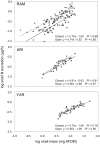Impacts of an invasive snail (Tarebia granifera) on nutrient cycling in tropical streams: the role of riparian deforestation in Trinidad, West Indies
- PMID: 22761706
- PMCID: PMC3382606
- DOI: 10.1371/journal.pone.0038806
Impacts of an invasive snail (Tarebia granifera) on nutrient cycling in tropical streams: the role of riparian deforestation in Trinidad, West Indies
Abstract
Non-native species and habitat degradation are two major catalysts of environmental change and often occur simultaneously. In freshwater systems, degradation of adjacent terrestrial vegetation may facilitate introduced species by altering resource availability. Here we examine how the presence of intact riparian cover influences the impact of an invasive herbivorous snail, Tarebia granifera, on nitrogen (N) cycling in aquatic systems on the island of Trinidad. We quantified snail biomass, growth, and N excretion in locations where riparian vegetation was present or removed to determine how snail demographics and excretion were related to the condition of the riparian zone. In three Neotropical streams, we measured snail biomass and N excretion in open and closed canopy habitats to generate estimates of mass- and area-specific N excretion rates. Snail biomass was 2 to 8 times greater and areal N excretion rates ranged from 3 to 9 times greater in open canopy habitats. Snails foraging in open canopy habitat also had access to more abundant food resources and exhibited greater growth and mass-specific N excretion rates. Estimates of ecosystem N demand indicated that snail N excretion in fully closed, partially closed, and open canopy habitats supplied 2%, 11%, and 16% of integrated ecosystem N demand, respectively. We conclude that human-mediated riparian canopy loss can generate hotspots of snail biomass, growth, and N excretion along tropical stream networks, altering the impacts of an invasive snail on the biogeochemical cycling of N.
Conflict of interest statement
Figures






Similar articles
-
Parasite infection alters nitrogen cycling at the ecosystem scale.J Anim Ecol. 2016 May;85(3):817-28. doi: 10.1111/1365-2656.12505. Epub 2016 Mar 25. J Anim Ecol. 2016. PMID: 26919319
-
Non-native earthworms in riparian soils increase nitrogen flux into adjacent aquatic ecosystems.Oecologia. 2008 Dec;158(3):499-510. doi: 10.1007/s00442-008-1149-0. Epub 2008 Sep 30. Oecologia. 2008. PMID: 18825416
-
Effects of Parasite Infection and Host Body Size on Habitat Associations of Invasive Aquatic Snails: Implications for Environmental Monitoring.J Aquat Anim Health. 2019 Mar;31(1):121-128. doi: 10.1002/aah.10059. Epub 2019 Feb 5. J Aquat Anim Health. 2019. PMID: 30582222
-
Testing the field of dreams hypothesis: functional responses to urbanization and restoration in stream ecosystems.Ecol Appl. 2011 Sep;21(6):1972-88. doi: 10.1890/10-0653.1. Ecol Appl. 2011. PMID: 21939038
-
Biological control of the snail hosts of Schistosoma mansoni in the Caribbean area using Thiara spp.Acta Trop. 1989 May;46(3):147-55. doi: 10.1016/0001-706x(89)90031-4. Acta Trop. 1989. PMID: 2566267 Review.
Cited by
-
Trade and Deforestation Predict Rat Lungworm Disease, an Invasive-Driven Zoonosis, at Global and Regional Scales.Front Public Health. 2021 Sep 9;9:680986. doi: 10.3389/fpubh.2021.680986. eCollection 2021. Front Public Health. 2021. PMID: 34568251 Free PMC article.
-
Predator-driven nutrient recycling in California stream ecosystems.PLoS One. 2013;8(3):e58542. doi: 10.1371/journal.pone.0058542. Epub 2013 Mar 8. PLoS One. 2013. PMID: 23520520 Free PMC article.
-
Assassin snails (Anentome helena) as a biological model for exploring the effects of individual specialisation within generalist predators.PLoS One. 2022 Mar 14;17(3):e0264996. doi: 10.1371/journal.pone.0264996. eCollection 2022. PLoS One. 2022. PMID: 35286318 Free PMC article.
References
-
- Vitousek PM, Mooney HA, Lubchenco J, Melillo JM. Human domination of Earth’s ecosystems. Science. 1997;277:494–499.
-
- Moulton LA, Pimm SL. The introduced Hawaiian avifauna: biogeographic evidence for competition. Am Nat. 1983;121:669–690.
-
- Vitousek PM. Biological invasions and ecosystem processes: towards an integration of population biology and ecosystem studies. Oikos. 1990;57:7–13.
-
- Baxter CV, Fausch KD, Murakami M, Chapman PL. Fish invasion restructures stream and forest food webs by interrupting reciprocal prey subsidies. Ecology. 2004;85:2656–2663.
-
- Vanni MJ. Nutrient cycling by animals in freshwater ecosystems. Annu Rev Ecol Syst. 2002;33:341–370.
Publication types
MeSH terms
Substances
LinkOut - more resources
Full Text Sources
Research Materials

